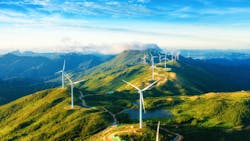Report: Renewable Energy Integration Key to Asia’s Decarbonization, Energy Transition
The integration of renewable energy into grid systems — more than simply deploying renewable energy to replace the region’s large dependence on coal — is the biggest challenge facing Asia’s electric industry, according to findings from this year’s Black & Veatch Asia Electric Report.
“The report reveals that pressures to lower grid emissions are mounting from investors, large customers and governments as infrastructure needs continue to transform,” said Narsingh Chaudhary, executive vice-president & managing director, Asia Pacific. “The introduction of more renewable energy, is changing the very nature of electric grid management and this means Asian electricity providers must plan and invest seriously across the entire system of generation, transmission and distribution assets.”
The need to focus investments beyond generation into transmission and distribution is underlined throughout the report. For example, 25% of industry respondents are not confident in the performance and resilience of their transmission and distribution systems. In addition, two of the top three threats to providing reliable service to customers are cited as underinvestment in transmission and insufficient energy storage.
“The energy transition is underway across the region with more than 80% of respondents saying they are channeling capital to clean energy investments,” said Harry Harji, associate vice-president for Black & Veatch's management consulting business in Asia. “Solar, in particular, looks set to receive increased investments over the next five years while almost half of respondents think hydrogen will emerge as an alternative to gas generation by 2030.”
Other key findings highlighted in the report include:
- Only 15% of respondents see a future for coal generation asset investment beyond 2035; in addition, 85% believe there will be less investment in coal over the next five years.
- In contrast, nearly half of respondents see a long-term future for new gas generation asset investments beyond 2035 while an additional 25% think investments will be channeled to upgrading existing facilities.
- This aligns with optimism around hydrogen as a zero-emissions energy carrier. 73% believe that hydrogen will help meet carbon emission goals beyond more than any other technology while 46% will take off as clean and affordable alternative to gas generation.
- Advance system control devices is the top investment priority area to improve transmission systems.
- Almost half of respondents are considering smart grid improvements in the next five years, more than any other grid hardening technique.
- 35% of industry respondents say their organization has no decarbonization response in place.
- The report also includes insights from large customers, surveyed for the first time.
